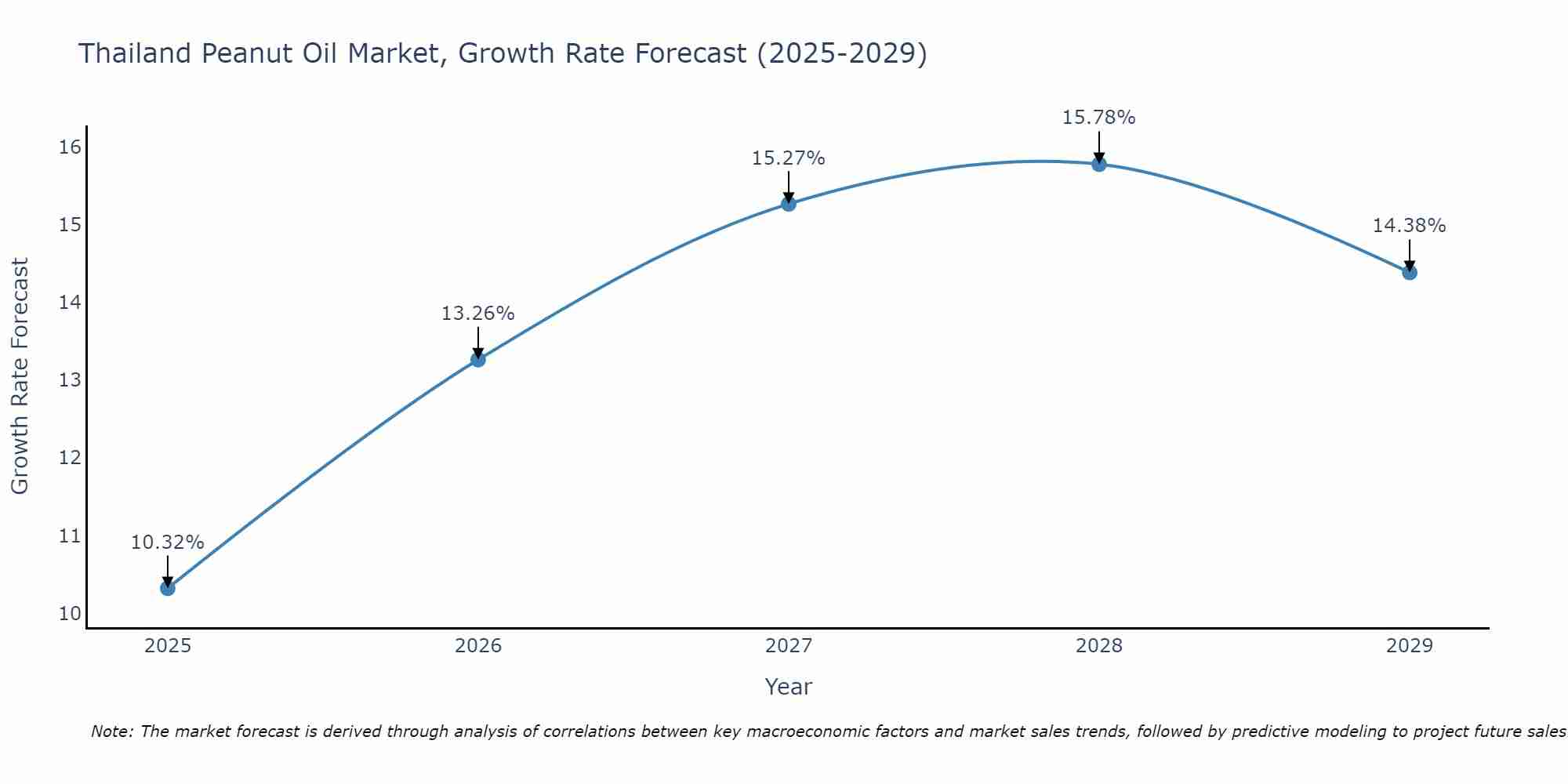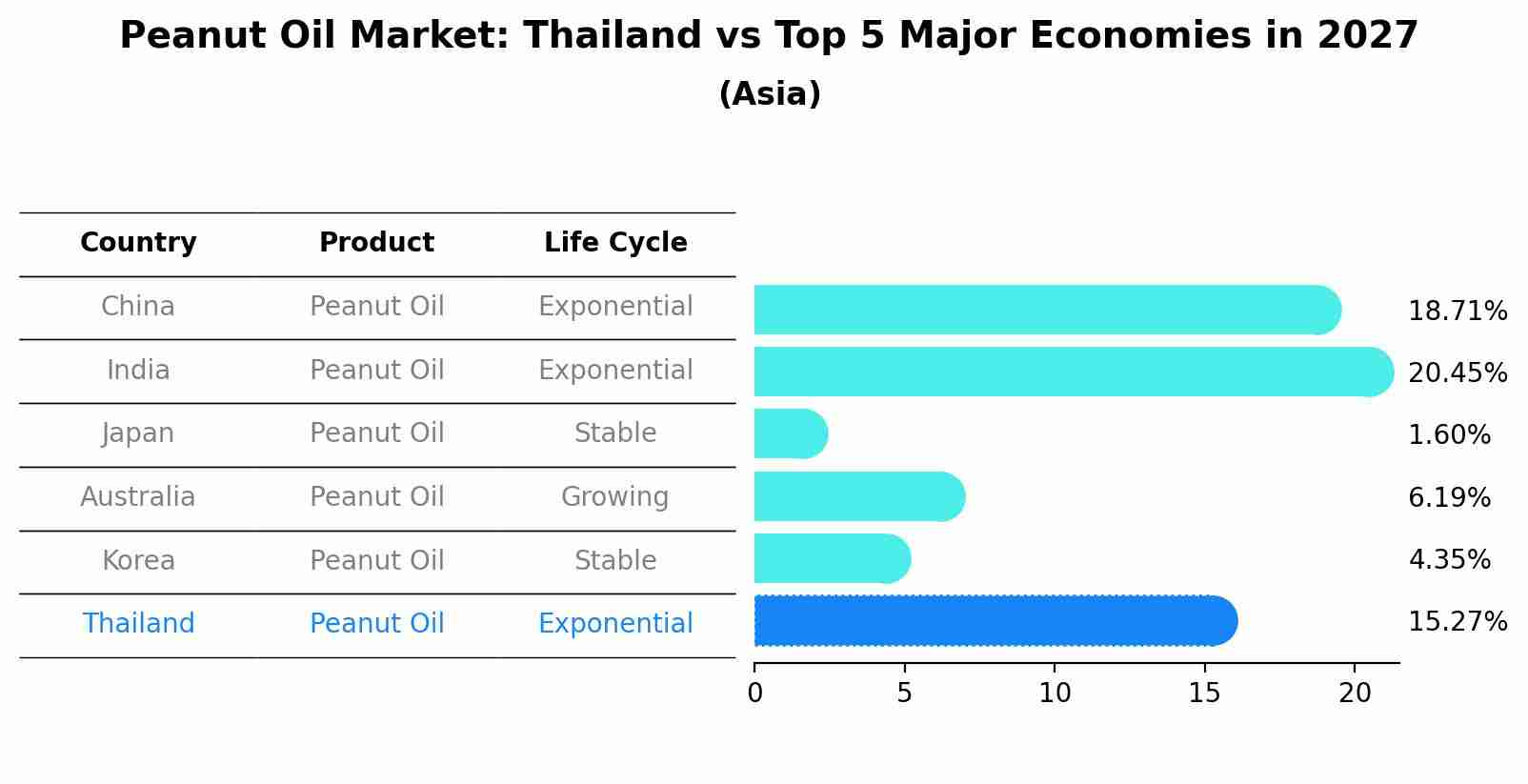Thailand Peanut Oil Market (2025-2031) Outlook | Trends, Value, Size, Share, Revenue, Industry, Growth, Forecast, Companies & Analysis
| Product Code: ETC223585 | Publication Date: Aug 2022 | Updated Date: Aug 2025 | Product Type: Market Research Report | |
| Publisher: 6Wresearch | No. of Pages: 75 | No. of Figures: 35 | No. of Tables: 20 | |
Thailand Peanut Oil Market Size Growth Rate
The Thailand Peanut Oil Market is projected to witness mixed growth rate patterns during 2025 to 2029. Starting at 10.32% in 2025, the market peaks at 15.78% in 2028, and settles at 14.38% by 2029.

Peanut Oil Market: Thailand vs Top 5 Major Economies in 2027 (Asia)
Thailand's Peanut Oil market is anticipated to experience a exponential growth rate of 15.27% by 2027, reflecting trends observed in the largest economy China, followed by India, Japan, Australia and South Korea.

Thailand Peanut Oil Market Synopsis
The Thailand Peanut Oil Market is a well-established market, with peanut oil being a staple cooking oil in Thai cuisine. Peanut oil is known for its distinct flavor and high smoke point, making it suitable for frying and stir-frying. The market is driven by both domestic consumption and export opportunities. Local producers focus on maintaining the quality and flavor profile that Thai consumers prefer, while also catering to international markets that seek authentic Thai ingredients. The market is competitive, with various brands vying for consumer attention.
Drivers of the Market
The Thailand Peanut Oil Market is driven by several factors, with one of the primary drivers being the widespread use of peanut oil in the country`s culinary traditions. Peanut oil is a staple in Thai cuisine, used for frying, stir-frying, and as a base for various sauces. Its high smoke point and neutral flavor make it an ideal cooking oil for many Thai dishes. Additionally, the growing awareness of the health benefits associated with peanut oil, such as its heart-healthy monounsaturated fats, vitamin E content, and antioxidants, has increased its popularity among health-conscious consumers. Moreover, the export potential of Thai peanut oil to international markets has also contributed to the growth of this market.
Challenges of the Market
Challenges include fluctuations in peanut production due to weather conditions, competition from other cooking oils, and addressing consumer concerns about allergies and health benefits. Ensuring product safety and quality is essential.
COVID-19 Impact on the Market
The Thailand Peanut Oil market faced supply chain disruptions and fluctuating demand during the pandemic. Health concerns prompted some consumers to seek alternative cooking oils. Peanut oil producers had to innovate by introducing healthier and premium peanut oil products while also adapting to e-commerce channels to reach consumers directly.
Key Players in the Market
Within the Thailand Peanut Oil market, NutraPeanut Oils Ltd. is a prominent player. They have a strong reputation for producing high-quality, cold-pressed peanut oil that retains the natural flavor and nutrition of peanuts. Their commitment to food safety and quality control has made them a trusted brand among consumers and culinary professionals. Additionally, Thai Nut Oils Co., Ltd. is known for its extensive distribution network and various peanut oil variants, serving both the retail and industrial sectors.
Key Highlights of the Report:
- Thailand Peanut Oil Market Outlook
- Market Size of Thailand Peanut Oil Market, 2024
- Forecast of Thailand Peanut Oil Market, 2031
- Historical Data and Forecast of Thailand Peanut Oil Revenues & Volume for the Period 2021-2031
- Thailand Peanut Oil Market Trend Evolution
- Thailand Peanut Oil Market Drivers and Challenges
- Thailand Peanut Oil Price Trends
- Thailand Peanut Oil Porter's Five Forces
- Thailand Peanut Oil Industry Life Cycle
- Historical Data and Forecast of Thailand Peanut Oil Market Revenues & Volume By Type for the Period 2021-2031
- Historical Data and Forecast of Thailand Peanut Oil Market Revenues & Volume By Refined for the Period 2021-2031
- Historical Data and Forecast of Thailand Peanut Oil Market Revenues & Volume By Unrefined for the Period 2021-2031
- Historical Data and Forecast of Thailand Peanut Oil Market Revenues & Volume By Application for the Period 2021-2031
- Historical Data and Forecast of Thailand Peanut Oil Market Revenues & Volume By Personal Care for the Period 2021-2031
- Historical Data and Forecast of Thailand Peanut Oil Market Revenues & Volume By Food for the Period 2021-2031
- Historical Data and Forecast of Thailand Peanut Oil Market Revenues & Volume By Pharmaceuticals for the Period 2021-2031
- Historical Data and Forecast of Thailand Peanut Oil Market Revenues & Volume By Other Applications for the Period 2021-2031
- Thailand Peanut Oil Import Export Trade Statistics
- Market Opportunity Assessment By Type
- Market Opportunity Assessment By Application
- Thailand Peanut Oil Top Companies Market Share
- Thailand Peanut Oil Competitive Benchmarking By Technical and Operational Parameters
- Thailand Peanut Oil Company Profiles
- Thailand Peanut Oil Key Strategic Recommendations
Frequently Asked Questions About the Market Study (FAQs):
1 Executive Summary |
2 Introduction |
2.1 Key Highlights of the Report |
2.2 Report Description |
2.3 Market Scope & Segmentation |
2.4 Research Methodology |
2.5 Assumptions |
3 Thailand Peanut Oil Market Overview |
3.1 Thailand Country Macro Economic Indicators |
3.2 Thailand Peanut Oil Market Revenues & Volume, 2021 & 2031F |
3.3 Thailand Peanut Oil Market - Industry Life Cycle |
3.4 Thailand Peanut Oil Market - Porter's Five Forces |
3.5 Thailand Peanut Oil Market Revenues & Volume Share, By Type, 2021 & 2031F |
3.6 Thailand Peanut Oil Market Revenues & Volume Share, By Application, 2021 & 2031F |
4 Thailand Peanut Oil Market Dynamics |
4.1 Impact Analysis |
4.2 Market Drivers |
4.2.1 Increasing consumer awareness about the health benefits of peanut oil |
4.2.2 Growing demand for natural and organic ingredients in food products |
4.2.3 Rising adoption of peanut oil in the food industry for its unique flavor profile |
4.3 Market Restraints |
4.3.1 Fluctuations in peanut production due to weather conditions |
4.3.2 Competition from other cooking oils in the market |
4.3.3 Price volatility of peanuts impacting the cost of peanut oil production |
5 Thailand Peanut Oil Market Trends |
6 Thailand Peanut Oil Market, By Types |
6.1 Thailand Peanut Oil Market, By Type |
6.1.1 Overview and Analysis |
6.1.2 Thailand Peanut Oil Market Revenues & Volume, By Type, 2021-2031F |
6.1.3 Thailand Peanut Oil Market Revenues & Volume, By Refined, 2021-2031F |
6.1.4 Thailand Peanut Oil Market Revenues & Volume, By Unrefined, 2021-2031F |
6.2 Thailand Peanut Oil Market, By Application |
6.2.1 Overview and Analysis |
6.2.2 Thailand Peanut Oil Market Revenues & Volume, By Personal Care, 2021-2031F |
6.2.3 Thailand Peanut Oil Market Revenues & Volume, By Food, 2021-2031F |
6.2.4 Thailand Peanut Oil Market Revenues & Volume, By Pharmaceuticals, 2021-2031F |
6.2.5 Thailand Peanut Oil Market Revenues & Volume, By Other Applications, 2021-2031F |
7 Thailand Peanut Oil Market Import-Export Trade Statistics |
7.1 Thailand Peanut Oil Market Export to Major Countries |
7.2 Thailand Peanut Oil Market Imports from Major Countries |
8 Thailand Peanut Oil Market Key Performance Indicators |
8.1 Consumer perception and demand for health-focused cooking oils |
8.2 Adoption rate of peanut oil in new product launches by food manufacturers |
8.3 Trends in peanut production and availability in Thailand |
9 Thailand Peanut Oil Market - Opportunity Assessment |
9.1 Thailand Peanut Oil Market Opportunity Assessment, By Type, 2021 & 2031F |
9.2 Thailand Peanut Oil Market Opportunity Assessment, By Application, 2021 & 2031F |
10 Thailand Peanut Oil Market - Competitive Landscape |
10.1 Thailand Peanut Oil Market Revenue Share, By Companies, 2024 |
10.2 Thailand Peanut Oil Market Competitive Benchmarking, By Operating and Technical Parameters |
11 Company Profiles |
12 Recommendations |
13 Disclaimer |
- Single User License$ 1,995
- Department License$ 2,400
- Site License$ 3,120
- Global License$ 3,795
Search
Related Reports
- ASEAN Bearings Market (2025-2031) | Strategy, Consumer Insights, Analysis, Investment Trends, Opportunities, Growth, Size, Share, Industry, Revenue, Segments, Value, Segmentation, Supply, Forecast, Restraints, Outlook, Competition, Drivers, Trends, Demand, Pricing Analysis, Competitive, Strategic Insights, Companies, Challenges
- Europe Flooring Market (2025-2031) | Outlook, Share, Industry, Trends, Forecast, Companies, Revenue, Size, Analysis, Growth & Value
- Saudi Arabia Manlift Market (2025-2031) | Outlook, Size, Growth, Trends, Companies, Industry, Revenue, Value, Share, Forecast & Analysis
- Uganda Excavator, Crane, and Wheel Loaders Market (2025-2031) | Strategy, Consumer Insights, Analysis, Investment Trends, Opportunities, Growth, Size, Share, Industry, Revenue, Segments, Value, Segmentation, Supply, Forecast, Restraints, Outlook, Competition, Drivers, Trends, Demand, Pricing Analysis, Competitive, Strategic Insights, Companies, Challenges
- Rwanda Excavator, Crane, and Wheel Loaders Market (2025-2031) | Strategy, Consumer Insights, Analysis, Investment Trends, Opportunities, Growth, Size, Share, Industry, Revenue, Segments, Value, Segmentation, Supply, Forecast, Restraints, Outlook, Competition, Drivers, Trends, Demand, Pricing Analysis, Competitive, Strategic Insights, Companies, Challenges
- Kenya Excavator, Crane, and Wheel Loaders Market (2025-2031) | Strategy, Consumer Insights, Analysis, Investment Trends, Opportunities, Growth, Size, Share, Industry, Revenue, Segments, Value, Segmentation, Supply, Forecast, Restraints, Outlook, Competition, Drivers, Trends, Demand, Pricing Analysis, Competitive, Strategic Insights, Companies, Challenges
- Angola Excavator, Crane, and Wheel Loaders Market (2025-2031) | Strategy, Consumer Insights, Analysis, Investment Trends, Opportunities, Growth, Size, Share, Industry, Revenue, Segments, Value, Segmentation, Supply, Forecast, Restraints, Outlook, Competition, Drivers, Trends, Demand, Pricing Analysis, Competitive, Strategic Insights, Companies, Challenges
- Israel Intelligent Transport System Market (2025-2031) | Strategy, Consumer Insights, Analysis, Investment Trends, Opportunities, Growth, Size, Share, Industry, Revenue, Segments, Value, Segmentation, Supply, Forecast, Restraints, Outlook, Competition, Drivers, Trends, Demand, Pricing Analysis, Competitive, Strategic Insights, Companies, Challenges
- Uganda Precast and Aggregate Market (2025-2031) | Strategy, Consumer Insights, Analysis, Investment Trends, Opportunities, Growth, Size, Share, Industry, Revenue, Segments, Value, Segmentation, Supply, Forecast, Restraints, Outlook, Competition, Drivers, Trends, Demand, Pricing Analysis, Competitive, Strategic Insights, Companies, Challenges
- Australia IT Asset Disposal Market (2025-2031) | Strategy, Consumer Insights, Analysis, Investment Trends, Opportunities, Growth, Size, Share, Industry, Revenue, Segments, Value, Segmentation, Supply, Forecast, Restraints, Outlook, Competition, Drivers, Trends, Demand, Pricing Analysis, Competitive, Strategic Insights, Companies, Challenges
Industry Events and Analyst Meet
Our Clients
Whitepaper
- Middle East & Africa Commercial Security Market Click here to view more.
- Middle East & Africa Fire Safety Systems & Equipment Market Click here to view more.
- GCC Drone Market Click here to view more.
- Middle East Lighting Fixture Market Click here to view more.
- GCC Physical & Perimeter Security Market Click here to view more.
6WResearch In News
- Doha a strategic location for EV manufacturing hub: IPA Qatar
- Demand for luxury TVs surging in the GCC, says Samsung
- Empowering Growth: The Thriving Journey of Bangladesh’s Cable Industry
- Demand for luxury TVs surging in the GCC, says Samsung
- Video call with a traditional healer? Once unthinkable, it’s now common in South Africa
- Intelligent Buildings To Smooth GCC’s Path To Net Zero













